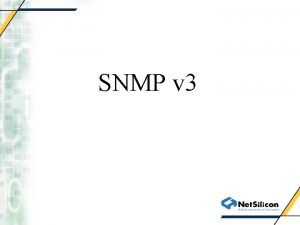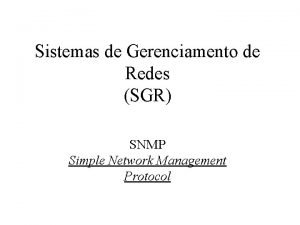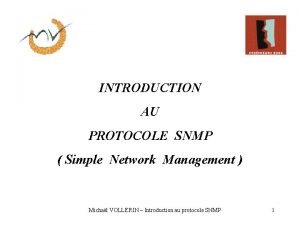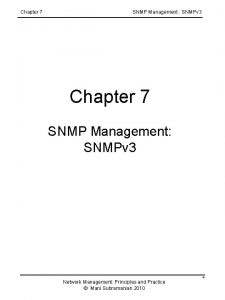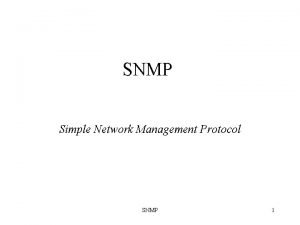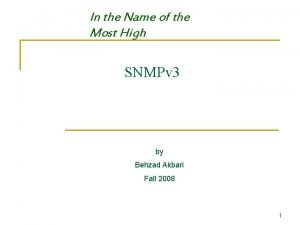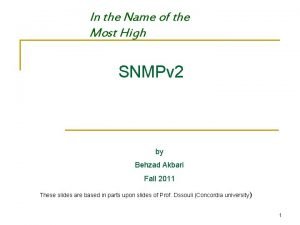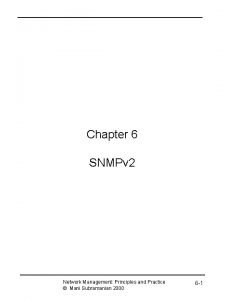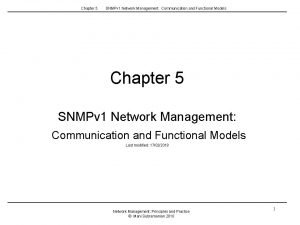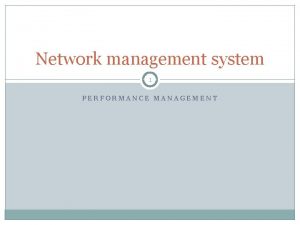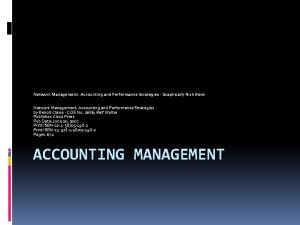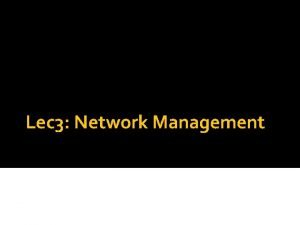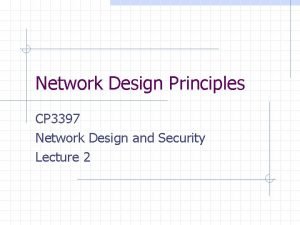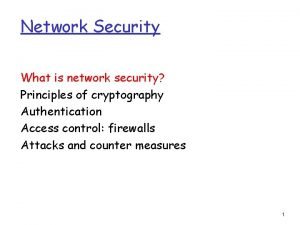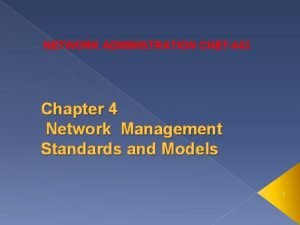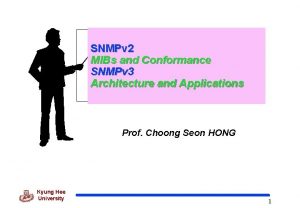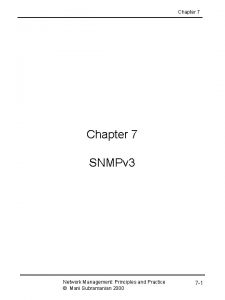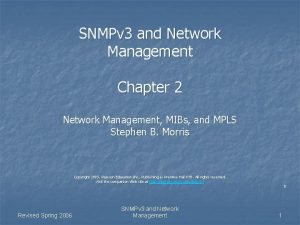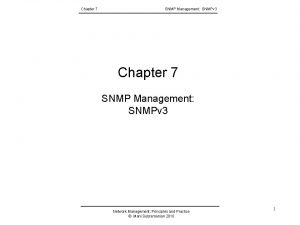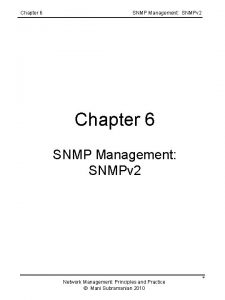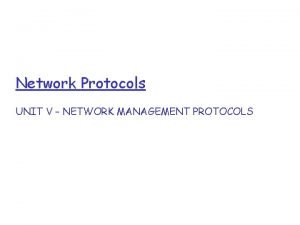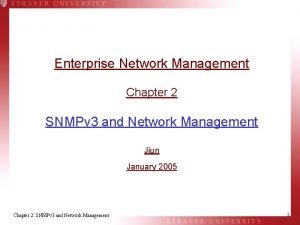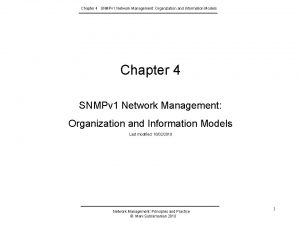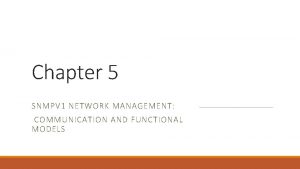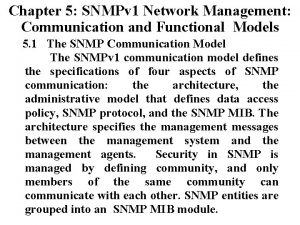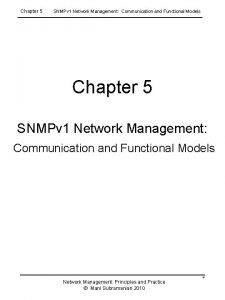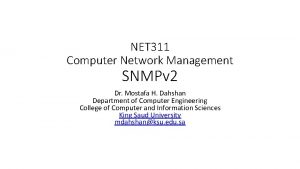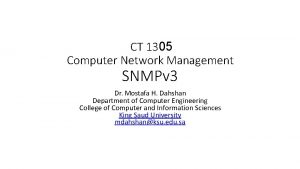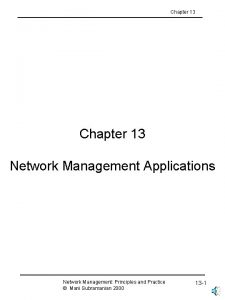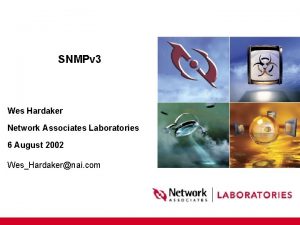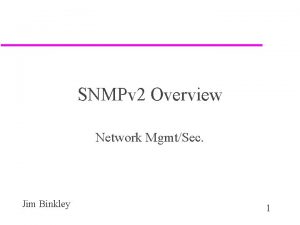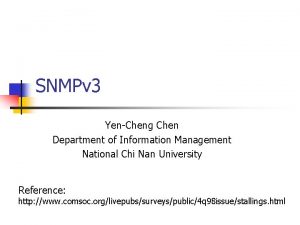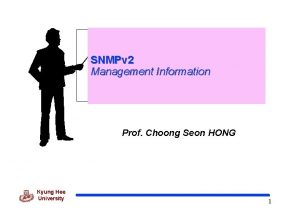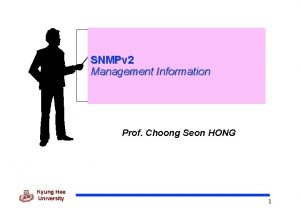Chapter 6 SNMPv 2 Network Management Principles and



































- Slides: 35

Chapter 6 SNMPv 2 Network Management: Principles and Practice © Mani Subramanian 2000 6 -1

Major Changes • Bulk data transfer • Manager-to-manager message • Enhancements to SMI: SMIv 2 • Module definitions: MODULE-IDENTITY macro • Object definitions: OBJECT-TYPE macro • Trap definitions: NOTIFICATION-TYPE macro • Textual conventions • Conformance statements • Row creation and deletion in table • MIB enhancements • Transport mappings Notes • Security features, originally to be in SNMPv 2 moved to SNMPv 3 • SNMPv 2, like SNMPv 1, is community-based administrative framework Network Management: Principles and Practice © Mani Subramanian 2000 6 -2

SNMPv 2 Internet Group Notes • Objects added to System group • Extensive modification of the SNMP group • Additional SNMPv 2 group added • Security group is a placeholder Network Management: Principles and Practice © Mani Subramanian 2000 6 -3

SNMPv 2 NM Architecture Network Management: Principles and Practice © Mani Subramanian 2000 6 -4

SNMPv 2 New Messages • inform-request • manager-to-manager message • get-bulk-request • transfer of large data • report • not used Notes Network Management: Principles and Practice © Mani Subramanian 2000 6 -5

Module Identity Macro Notes • Module is a group of related assignments • MODULE-IDENTITY macro defines the module definitions Network Management: Principles and Practice © Mani Subramanian 2000 6 -6

OBJECT ? ? • OBJECT IDENTIFIER defines the administrative identification of a node in the MIB • OBJECT-IDENTITY macro assigns an object identifier to an object identifier in the MIB • OBJECT-TYPE macro defines the type of a managed object Notes Network Management: Principles and Practice © Mani Subramanian 2000 6 -7

OBJECT-IDENTITY / OBJECT-TYPE • OBJECT-IDENTITY is high level description • OBJECT-TYPE details description needed for implementation Network Management: Principles and Practice © Mani Subramanian 2000 6 -8

Table Expansion • Augmentation of a table (dependent table) adds additional columns to an existing table (base table) • Dense table enables addition of more rows to base table • Sparse table supplements less rows to a base table Notes Network Management: Principles and Practice © Mani Subramanian 2000 6 -9

Augmentation of Tables Network Management: Principles and Practice © Mani Subramanian 2000 6 -10

Augmentation of Tables: Example Network Management: Principles and Practice © Mani Subramanian 2000 6 -11

Textual Convention • Enables defining new data types • Makes semantics of data types consistent and human readable • Creates new data types using existing ones and applies restrictions to them • An important textual convention in SNMPv 2, Row. Status creates and deletes rows Notes • SNMPV 1: • SNMPv 2: Network Management: Principles and Practice © Mani Subramanian 2000 6 -12

Creation of Row: Row. Status Notes • Status: A new column is added to the conceptual table • SYNTAX of Status is Row. Status • Value of Row. Status is Enumerated INTEGER Network Management: Principles and Practice © Mani Subramanian 2000 6 -13

Row Creation and Deletion Notes Network Management: Principles and Practice © Mani Subramanian 2000 6 -14

Create-and-Go Row Creation Network Management: Principles and Practice © Mani Subramanian 2000 6 -15

Create-and-Wait: Row Creation Network Management: Principles and Practice © Mani Subramanian 2000 6 -16

Row Deletion Network Management: Principles and Practice © Mani Subramanian 2000 6 -17

SNMPv 2 MIB Notes • Security is a placeholder • System group: A table sys. ORTable added that lists resources that the agent controls; NMS configures NE through the agents. • Most of the objects in the SNMPv 1 obsoleted • Object Groups and Notification Groups defined for conformance specifications. Network Management: Principles and Practice © Mani Subramanian 2000 6 -18

Conformance: OBJECT-GROUP • Conformance defined by • OBJECT-GROUP macro • NOTIFICATION-GROUP macro • OBJECT-GROUP • Compiled during implementation, not at run time • OBJECTS clause names each object • Every object belongs to an OBJECT-GROUP • Access defined by MAX-ACCESS, the maximum access privilege for the object Notes Network Management: Principles and Practice © Mani Subramanian 2000 6 -19

Conformance: NOTIFICATION-GROUP • Contains trap entities defined in SMIv 1 • NOTIFICATIONS clause identifies the notifications in the group • NOTIFICATIONS-GROUP macro compiled during implementation, not at run time Notes Network Management: Principles and Practice © Mani Subramanian 2000 6 -20

Compliance • Compliance has two classes of groups • MANDATORY-GROUPS. . . Required • GROUP …Optional Notes Network Management: Principles and Practice © Mani Subramanian 2000 6 -21

Agent Capabilities • AGENT-CAPABILITIES macro • SUPPORTS modules and includes groups • VARIATION identifies additional features Notes Network Management: Principles and Practice © Mani Subramanian 2000 6 -22

SNMPv 2 SNMP MIB Notes Network Management: Principles and Practice © Mani Subramanian 2000 6 -23

snmp. MIBObjects MIB Notes Network Management: Principles and Practice © Mani Subramanian 2000 6 -24

SNMPv 2 PDU Notes • Standardized format for all messages • Interpretation of error status and error index fields; In v 1, if error occurs status and index field filled, but va Interpretation var. Bind. List ignored var. Bind of index field ignored Network Management: Principles and Practice © Mani Subramanian 2000 Status x x 6 -25

SNMPv 2 PDU and Error Status Network Management: Principles and Practice © Mani Subramanian 2000 6 -26

SNMPv 2 Get. Bulk. Request PDU Notes • Error status field replaced by Non-repeaters • Error index field replaced by Max repetitions • No one-to-one relationship between request and respon Network Management: Principles and Practice © Mani Subramanian 2000 6 -27

Get-Bulk-Request: Generic MIB Network Management: Principles and Practice © Mani Subramanian 2000 6 -28

Get-Next-Request Operation Network Management: Principles and Practice © Mani Subramanian 2000 6 -29

Get-Bulk-Request Operation Network Management: Principles and Practice © Mani Subramanian 2000 6 -30

Get-Bulk-Request Example Notes Network Management: Principles and Practice © Mani Subramanian 2000 6 -31

SNMPv 2 Trap Notes • Addition of NOTIFICATION-TYPE macro • OBJECTS clause, if present, defines order of variable bi • Positions 1 and 2 in Var. Bind. List are sys. Up. Time and snm Network Management: Principles and Practice © Mani Subramanian 2000 6 -32

Inform-Request Notes • Inform-Request behaves as trap in that the message go manager to another unsolicited • The receiving manager sends response to the sending m Network Management: Principles and Practice © Mani Subramanian 2000 6 -33

Bilingual Manager Notes • Compatibility with SNMPv 1 • Bilingual Manager • Proxy Server • Bilingual Manager expensive in resource and operation Network Management: Principles and Practice © Mani Subramanian 2000 6 -34

SNMP Proxy Server Network Management: Principles and Practice © Mani Subramanian 2000 6 -35
 Snmp 2 vs 3
Snmp 2 vs 3 Snmpv
Snmpv Snmpv
Snmpv Snmp couche osi
Snmp couche osi Snmpv
Snmpv Arquitectura snmp
Arquitectura snmp Snmpv
Snmpv Snmpv
Snmpv Snmpv
Snmpv Snmpv
Snmpv Network management principles
Network management principles Network management principles and practice
Network management principles and practice Network performance management system
Network performance management system Accounting management in network management
Accounting management in network management Managing entity network management
Managing entity network management Accounting management in network management
Accounting management in network management Principles of project cost management
Principles of project cost management A switch in a datagram network uses a
A switch in a datagram network uses a Features of peer to peer network and client server network
Features of peer to peer network and client server network Network centric computing
Network centric computing What is topology in computer
What is topology in computer Ece 526
Ece 526 Packet switched vs circuit switched
Packet switched vs circuit switched Principles of network applications
Principles of network applications Principles of network applications
Principles of network applications Network leadership principles
Network leadership principles Network design principles
Network design principles Letoutr
Letoutr Firewall design principles
Firewall design principles Top management and middle management
Top management and middle management Management pyramid
Management pyramid Top management and middle management
Top management and middle management Osi network management model
Osi network management model Network design and management
Network design and management Project management principles and practices
Project management principles and practices Project management principles and practices
Project management principles and practices
